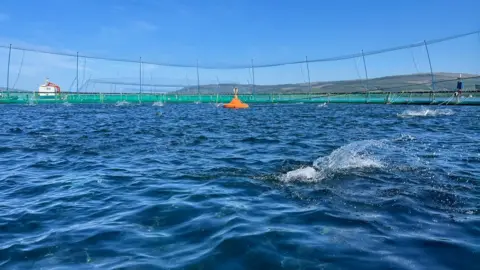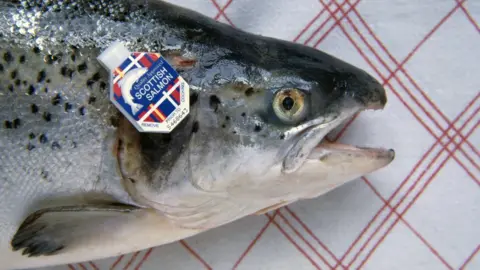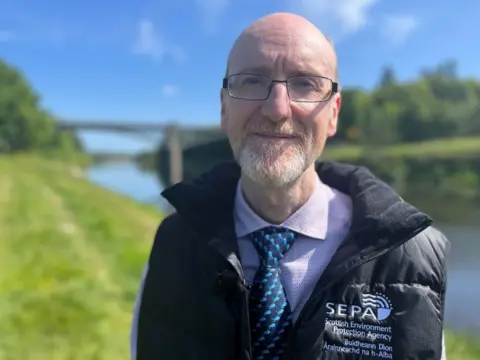Zones planned to protect wild salmon from sea lice
 BBC
BBCAn extensive network of wild salmon protection zones is being proposed along Scotland's west coast.
Industry regulator Sepa wants to halt the long-term decline of the Atlantic wild salmon population by reducing sea lice outbreaks from fish farms.
Under the plans, operators in the protection zones will have to keep sea lice numbers to low levels and face additional monitoring.
The industry said it was concerned about over-regulation.
But conservationists said the move was still not enough and called for more enforcement action taken against fish farms with significant outbreaks.
There are more than 200 farms of caged salmon in the sea or lochs close to Scotland's west coast, producing 200,000 tonnes of the fish each year, worth £360m to the Scottish economy.
Sea lice are marine parasites which attach themselves to salmon causing damage to their skin.
They can spread quickly through fish farms when untreated, as well as to migrating wild salmon.
Protecting wild salmon is a serious concern with stocks falling from about nine million in the 1970s to about three million today.
Two Scottish Parliament inquiries have identified that action is needed to protect the iconic fish species.
 Getty Images
Getty ImagesA new sea lice framework has been published by the Scottish Environment Protection Agency (Sepa) which will now go to consultation.
About 120 potential zones of varying sizes have been identified along the west coast and Western Isles, in areas through which wild salmon migrate.
The majority of existing fish farms will sit within the zones but eight areas have been selected where Sepa wants to concentrate its efforts.
The largest are in and around Loch Fyne, Loch Linnhe and Loch Carron.
Sepa says it has identified 21 fish farms within those eight zones which collectively see the most sea lice outbreaks.
Those farms will be told to keep lice numbers below specified levels although Sepa will leave it to operators to decide the methods they use to achieve those targets.

Sepa's head of ecology, Peter Pollard, told BBC Scotland: "We've done some scenario modelling and it shows that tighter but achievable lice control on those farms would be sufficient to achieve levels that protect salmon."
He said demonstrating that farms were protecting the environment was good for the wild fish and for the reputation of the industry.
Sepa are keen to point out that the plans do not include any "no-go" areas.
The regulator is acutely aware of the anger in small coastal communities caused by the Scottish government's plans to create Highly Protected Marine Areas (HPMAs), which will restrict all commercial activity within 10% of Scotland's waters.
HPMAs have been likened to the Highland Clearances, with some suggesting they will devastate many areas.
The fish farm industry says it has been investing in innovative techniques to control sea lice numbers such as introducing other fish species to their cages, known as "cleaner fish", which eat the sea lice that have attached themselves to the salmon.
However there are concerns that too much regulation could become burdensome.
Anne Anderson from Scottish Sea Farms said sea lice was not an issue for farmed fish.
"We are keeping and operating at very low levels now," she said.
Ms Anderson added: "I'm concerned about more regulation when there is not an evidence base for it.
"The salmon sector is under a very robust regime already."
Tavish Scott, chief executive of Salmon Scotland, said the sector was "constantly innovating to tackle naturally-occurring challenges like sea lice".
He added: "The most significant challenge to wild salmon is climate change and loss of habitat, as Sepa has acknowledged, and the focus for regulators must therefore be on improving water quality."
Conservationists have long raised concerns about the number of salmon which have been dying in fish farms.
In recent years the salmon farming sector has published weekly data about fish mortality.
The new framework will place an additional requirement on operators to collect and share data about the health of their stocks.

But Rachel Mulrenan from the conservation charity Wild Fish believes the plans being set out still do not go far enough.
She said: "At first glance, it's a good idea but the devil is really in the detail. From our perspective the concerns are the upper sea lice limit that's being proposed - it's already too lenient.
"You've got verification of data that is desperately needed. At the moment it's industry-supplied data which is not verified, and there's also quite a few loopholes for reporting.
"And thirdly, you've also got the enforcement because if these regulations aren't going to be enforced, then what's the point having the regulations?"
Dwindling wild salmon numbers have been attributed to a range of causes including rising sea temperatures caused by climate change.
The regulator said steps had to be taken to give young fish the best possible chance of survival as they head out to sea from Scotland's rivers.
That includes tackling sea lice outbreaks.
